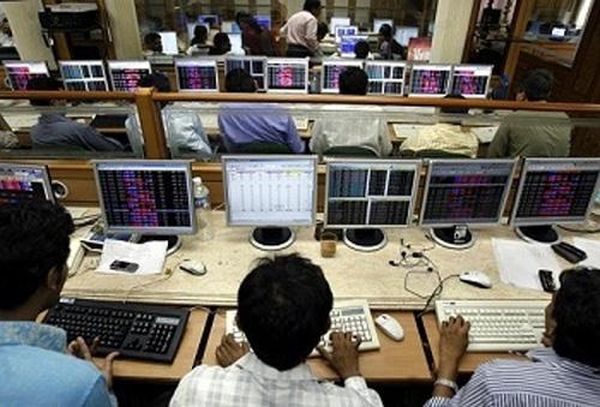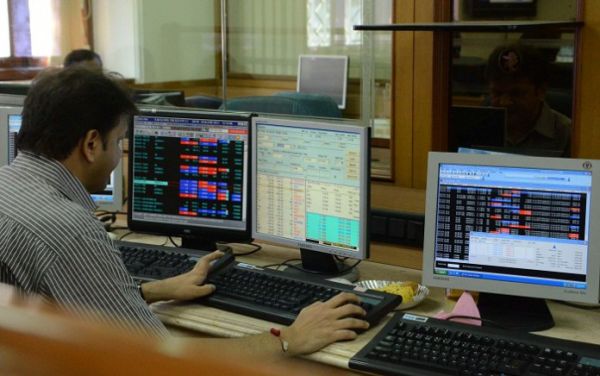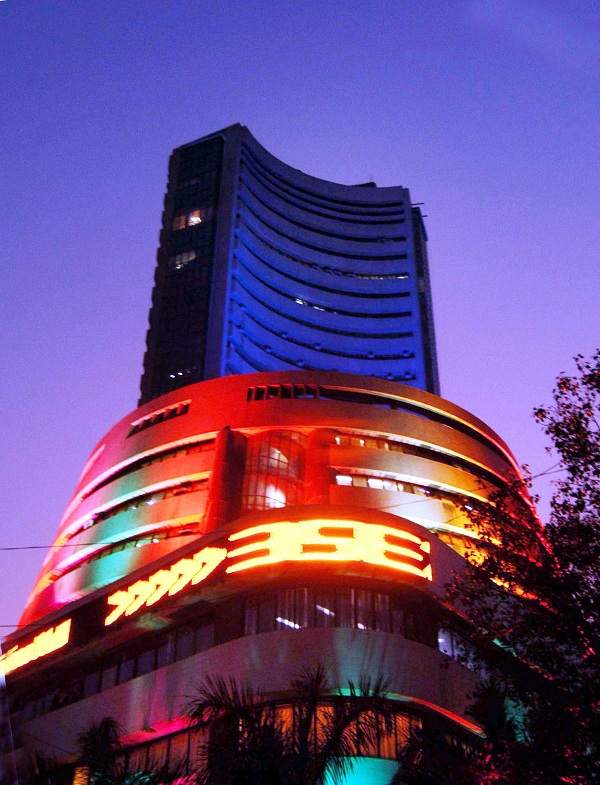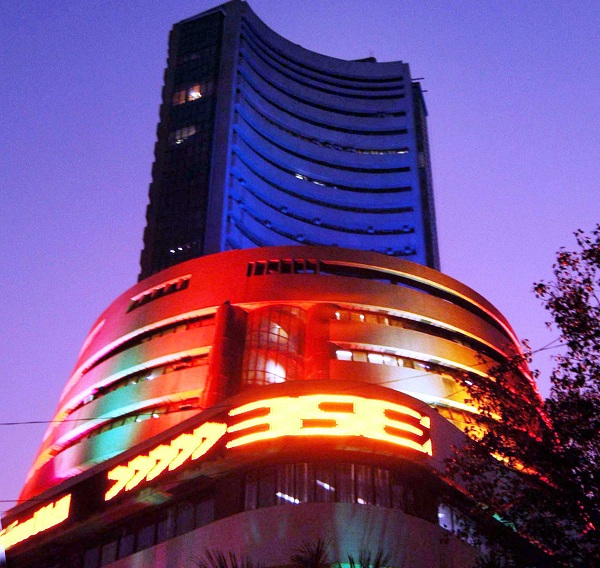
by admin | May 25, 2021 | Banking, Business, Economy, Finance, Investing, Markets, News, SMEs
 By Porisma P. Gogoi
By Porisma P. Gogoi
Mumbai : Continuing the bull run for the second consecutive week, key Indian equity indices — the Sensex and the Nifty50 — closed with minimal gains as short covering in healthcare and banking stocks coupled with continuous purchasing activities by domestic institutional investors (DIIs) kept market sentiment afloat.
On a weekly basis, the 30-scrip Sensitive Index (Sensex) of the BSE rose by 71.38 points or 0.99 per cent to close at 31,596.06 points.
Meanwhile, the Nifty50 of the National Stock Exchange (NSE) closed at 9,857.05 points, up 19.65 points or 0.2 per cent.
“Nifty witnessed minor upside bounce this week and closed the week with minor gains of around 20 points (0.20 per cent). Sectorally, the top weekly gainers were the pharma, metal and banking indices, while the losers were IT and FMCG indices,” Deepak Jasani, Head of Retail Research, HDFC Securities, told IANS.
According to D.K. Aggarwal, Chairman and Managing Director, SMC Investments and Advisors, the domestic market took pressure due to crack-down of market regulator Securities and Exchange Board of India (SEBI) on shell companies and geopolitical tension between India-China and USA-North Korea.
“However, on Wednesday, domestic market moved little higher aided by fresh buying mainly in realty, healthcare and banks, coupled with positive global cues,” Aggarwal told IANS.
“Also, the news that the Union Cabinet has moved another step towards the merger of some of the state-owned banks supported the bulls.”
On August 23, Finance Minister Arun Jaitley announced that “in principle” approval has been granted by the Union Cabinet for the consolidation of state-run banks through mergers. The announcement led to massive gains in public sector bank’s (PSU banks) stocks.
On the currency front, the Indian rupee strengthened by 10-11 paise to close the week at 64.03-04 to a US dollar from its previous week’s close at 64.14.
Vinod Nair, Head of Research, Geojit Financial Services, observed that pull-out of foreign funds and persistent miss in quarter earnings, which could end up with drop in FY18 profit-after-tax estimate, kept investors a little jittery.
“Month-to-date, foreign institutional investors (FIIs) were net sellers in the market on concerns of premium valuation, whereas DIIs continued to pour money into domestic market, which is keeping the market trend positive. Further, short covering due to shorter trading days (Friday which is a holiday) and nearness of August futures and options (F&O) expiry also supported the sentiment,” said Nair.
Provisional figures from the stock exchanges showed that FIIs sold stocks worth Rs 4,666.53 crore, while DIIs bought scrips worth Rs 2,883.99 crore during August 21-24.
Figures from the National Securities Depository (NSDL) revealed that foreign portfolio investors (FPIs) divested equities worth Rs 5,281.52 crore, or $824.17 million, during the trade week ended August 24.
“IT sector continued to witness pressure due to recent management turbulence in Infosys despite a premium buyback announcement. NPA (non-performing assets) worries in PSU Banks may cloud the outlook, whereas cabinet nod for fast track consolidation of PSU banks attain investors attention,” added Nair.
The top weekly Sensex gainers were: Bharti Airtel (up 3.95 per cent at Rs 433); Lupin (up 3.95 per cent at Rs 991.75); Dr Reddy’s Lab (up 3.88 per cent at Rs 2,087.90); Tata Steel (up 2.09 per cent at Rs 638.95); and Axis Bank (up 1.77 per cent at Rs 505.60).
The losers were: Infosys (down 10.64 per cent at Rs 912.50); NTPC (down 4.35 per cent at Rs 169.15); Bajaj Auto (down 3.15 per cent at Rs 2,731.85); Hero MotoCorp (down 3.06 per cent at Rs 3,874.50); and Adani Ports (down 2.64 per cent at Rs 379.95).
(Porisma P. Gogoi can be contacted at porisma.g@ians.in)
—IANS

by admin | May 25, 2021 | Business, Investing
 Mumbai, (IANS) : Positive global cues, along with short covering buoyed the Indian equity markets during the early morning trade session on Tuesday.
Mumbai, (IANS) : Positive global cues, along with short covering buoyed the Indian equity markets during the early morning trade session on Tuesday.
Investors’ risk taking appetite was enhanced following US electoral developments, such as the clean chit given by the US investigators to the Democratic presidential nominee Hillary Clinton.
The US presidential election will be held on Tuesday.
The wider 51-scrip Nifty of the National Stock Exchange (NSE) gained 31.55 points or 0.37 per cent to 8,528.60 points.
The barometer 30-scrip sensitive index (Sensex) of the BSE, which opened at 27,537.26 points, traded at 27,542.41 points (at 9.35 a.m.) — up 83.42 points or 0.30 per cent from the previous close at 27,458.99 points.
The Sensex has so far touched a high of 27,600.71 points and a low of 27,508.43 points during the intra-day trade.
The BSE market breadth was firmly in favour of the bulls — with 1,259 advances and 448 declines.
On Monday, the Indian equity markets closed in the green due to positive global cues.
The barometer index rose by 184.84 points or 0.68 per cent to 27,458.99 points, while the NSE Nifty edged up by 63.30 points or 0.75 per cent to 8,497.05 points.

by admin | May 25, 2021 | Corporate, Corporate Buzz

Bombay Stock Exchange
Mumbai:(IANS) Bargain hunting and unravelling of short positions by investors propelled a barometer index of the Indian equities markets into making gains during the mid-afternoon trading session on Thursday.
The barometer 30-scrip sensitive index (Sensex) of the Bombay Stock Exchange (BSE) made gains after six consecutive days of losses. It was higher by 167 points or 0.67 percent during the mid-afternoon trade session.
Similarly, the wider 50-scrip Nifty of the National Stock Exchange (NSE) was higher during the session under review. It rose by 46 points or 0.60 percent at 7,658.05 points.
The Sensex of the S&P Bombay Stock Exchange (BSE), which opened at 25,136.71 points, was trading at 25,203 points (at 2.20 p.m.) — up 167 points or 0.67 percent from the previous day’s close at 25,036.05 points.
The Sensex so far touched a high of 25,259.06 points and a low of 25,034.14 points during the intra-day trade.
The barometer index had receded by 1,134.23 points during the last six consecutive sessions, whereas the NSE Nifty declined by 343 points.
Market observers said short coverings of position by investors led the relief rally after six consecutive days of losses.
“Markets are trading in the green after six straight sessions of losses led by covering of short positions by traders,” Vaibhav Agarwal, vice president and research head at Angel Broking, told IANS.
Agarwal pointed out that markets positive trajectory might be short-lived due to the logjam in parliament and absence of fresh triggers.
“We do not expect any meaningful upside from current levels in the absence of any major trigger,” Agarwal elaborated.
“Investors will watch out for inflation and industrial production data over the next couple of days, for further direction. We also expect volatility to spike next week ahead of the US FOMC (Federal Open Market Committee) meet.”
Lately investors confidence was eroded due to the logjam in parliament which has dimmed the prospects of the Goods and Services Tax (GST) bill getting passed during the winter session.
Should the bill not secure clearance in this session, it will miss its intended roll-out date of April 1 next year.
Moreover, the continued selling of equities by the foreign investors ahead of a likely US rate hike and the upcoming domestic macro-economic data points, slated to be released on Friday, spooked investors.

by admin | May 25, 2021 | Corporate, Corporate finance, Economy, News

Bombay Stock Exchange(Photo;Maeeshat)
Mumbai:(IANS) Samvat 2072, marking the start of the Hindu New Year, began on a positive note for Indian equities at a special trading session held on Wednesday.
Held every year on Diwali day, the special trading session saw both the bellwether indices of the Indian equities markets make healthy gains.
The annual one-hour special “muhurat” session was held between 5.45 p.m and 6.45 p.m.
The 50-scrip Nifty of the National Stock Exchange (NSE) made modest gains during the intra-session trade. It ended higher by 41.65 points or 0.54 percent at 7,825 points.
Furthermore, the 30-scrip sensitive index (Sensex) of the S&P Bombay Stock Exchange (BSE) augmented during the special trading session.
The S&P BSE Sensex, which opened 25,934.90 points, closed at 25,866.95 points — up 123.69 points or 0.48 percent from the previous day’s close at 25,743.26 points.
The Sensex touched a high of 25,944.93 points and a low of 25,853.42 points during the intra-session trade.
The S&P BSE Sensex had closed the previous day’s trade down 392 points or 1.50 percent.
“The government’s reforms proposals announced yesterday to hike foreign direct investment (FDI) limits in various sectors provide a sentiment boost to the investors,” Anand James, co-head, technical research desk with Geojit BNP Paribas Financial Services, told IANS.
“Investors were also focusing on the upcoming winter session and heightened chances of more reforms being pushed through this session like the goods and services tax (GST).”
The Samvat 2071 had proved to be the worst in four years for the S&P BSE Sensex, which shed over 1,100 points or 4.13 percent in the Diwali-to-Diwali Hindu fiscal which drew to a close on Tuesday.
The Hindu fiscal year Samvat 2071 had started at the level of 26,851.05 points — that is the closing level at the end of the special trading session of Diwali last year, on October 23, 2014.
The previous three Hindu fiscal Samvats ended on a positive note, with the index gaining 26.42 percent in 2014, 14.07 percent in 2013 and 7.69 percent in 2012.
It was during a year before that — in 2012 — that the Sensex took a major hit, down 17.69 percent. The previous close in the negative was the 52.36 percent fall in 2008.
Analysts said that high expectations, the government’s inability to push key reforms and global market turmoil such as the Greece crisis, slowing Chinese economy and an impending US rate hike dented investors’ confidence.
“The market expectations were very high after the last year’s exponential rise, formation of a single party government at the centre and its reforms agenda,” James added.
“The upward trend since last Diwali was not sustained beyond March 2015, as political developments, slower pace of reforms and disappointing results eroded investors confidence.”
Sector-wise during the day the special trade session all 12 indices closed with healthy gains.
The S&P BSE capital goods index augmented by 205.32 points, healthcare index gained by 175.42 points, banking index rose by 170.58 points, automobile index edged higher by 94.26 points and metal index was up 68.72 points.
Major Sensex gainers during Wednesday’s trade were Axis Bank, up 2.50 percent at Rs.480.20; Sun Pharma, up 1.93 percent at Rs.746.55; Larsen and Toubro (L&T), up 1.41 percent at Rs.1,366.50; Tata Steel, up 1.33 percent at Rs.220.85; and BHEL, up 1.23 percent at Rs.180.55.
The major Sensex losers were Bharti Airtel, down 0.60 percent at Rs.330; Hero MotoCorp, down 0.49 percent at Rs.2,644.40; ITC, down 0.46 percent at Rs.335; NTPC, down 0.38 percent at Rs.131; and ONGC, down 0.19 percent at Rs.236.50.

by admin | May 25, 2021 | Corporate, Corporate Governance

Mumbai:(IANS) This is not the first time that the issue of participatory notes or P-Notes has rocked Indian stock markets. Precisely, seven years, nine months and ten days ago, a similar issue had sent key indices tumbling. A recall:
On the evening of Oct 16, 2007, after the trading hours, markets watchdog Securities and Exchange Board of India had sought to regulate the use of P-Notes — the most preferred route or instrument — to invest in Indian stock markets.
Neither the then United Progressive Alliance (UPA) government nor the watchdog had liked the idea of anonymity of an investor. They felt if P-Notes were left unregulated, such investments — particularly those with hedge funds — could create unwanted volatility in the markets.
The next day, the investor reaction was something the policy-makers wouldn’t have anticipated. The sensitive index (Sensex) of the Bombay Stock Exchange (BSE) opened as much as 1,013.96 points lower on Oct 17, 2007 at 18,037.90 points, over the previous close at 19,051.86 points.
Within a minute or so, it crashed further to 17,307.90 points — that is a loss of 1,743.96 points or 9.15 percent, over the previous day’s close, which was the biggest fall in absolute terms and among the steepest in percentage terms.
Automatically, trading was suspended for an hour.
After due consultations with officials, including the markets watchdog, then finance minister P. Chidambaram issued some clarifications. An official note also followed:
“In consultation with the Reserve Bank of India and the Securities and Exchange Board of India, the government proposed to take certain measures to moderate capital inflows. These measures are in the overall interest of the economy and of the market and investors,” it said.
“Proposed measures include some restrictions on the issue of offshore derivative instruments by foreign institutional investors and their sub-accounts in relation to their exposure in market. Neither do these suggest nor is there any intention to ban issue of such instruments,” it added.
When the markets re-opened, there was a significant rebound. The Sensex rose 1,533.39 points (the day’s low) to the day’s high of 18,841.29 points, and it eventually closed at 18,715.82 — with a somewhat lower loss of 336.04 points, or 1.76 percent.
But the story of the crash and the rebound did not end there. The next day, the mood continued to be sullen, resulting in a loss of 717.43 points, followed by a fall of another 438.41 points the day after, which was a Friday.
Once trading began on Monday, after a two-day holiday, the markets started reacting positively after some initial hiccups, ending with a marginal gain of 54.01 points. The next trading day, however, marked a smart recovery of 878.85 points.
Over the next two days, the Sensex rose — by 20.07 points and again by an impressive 878.85 points — to close on Thursday at 18,770.89 points, by which time all the losses incurred over a six-day period, beginning Oct 17, had been recovered.
The market rally continued on Friday with a gain of another 472.28 points, and by Monday, the Sensex had breached the psycologically-important 20,000-point level — all these developments within the matter of just nine trading days.
But what are these P-Notes in financial jargon, that have have come to haunt Indian equities once again? What are the government’s concerns and why have they evoked such strong reactions from investors?
P-Notes, or just PNs, are financial instruments used by foreign funds to invest in the Indian stock markets on behalf of their overseas clients who do not wish to register themselves with the markets regulator.
There are hordes of clients who wish to invest in Indian equities, but not directly as enrolled entities with the regulator but in an informal manner through their India-based brokerages, who issue participatory notes for the shares bought on their behalf.
In the process, the anonymity of the clients is maintained. Accordingly, some large funds, notably those who hedge their investments across markets, are able to invest in a discreet manner without evoking much market attention.
For such clients, trading through PNs is not only easier, as they can be freely transferred like a contract note, but also help them avail of tax benefits that are available in some tax havens, like Mauritius.
What’s the concern now? A special probe team on black money, set up at the behest of the apex court, has suggested that these need to be regulated. For, they are perceived as a major instrument for unaccounted money sent abroad through hawala to be routed back discreetly.
For the moment, Finance Minister Arun Jaitley has sought to assuage the feelings.
“No step will be taken that can adversely impact investment sentiment. The government will certainly not take any such action in a knee-jerk fashion, particularly one which has any adverse impact on investment environment,” he told reporters here on Monday.
But the markets respond in their own way!





